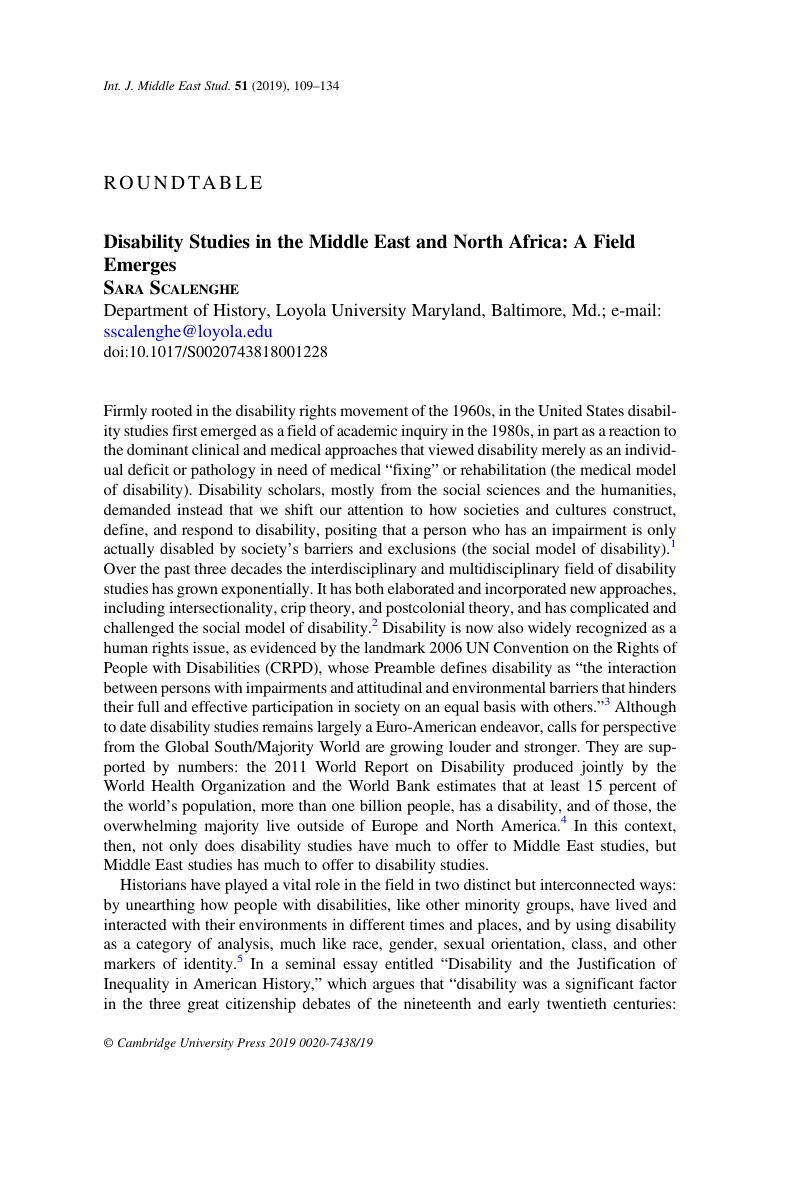Published online by Cambridge University Press: 14 January 2019

1 A classic example is the absence of ramps for a wheelchair user, which turns a motor impairment into a disability.
2 For an overview of the field and its history, see Goodley, Dan, Disability Studies: An Interdisciplinary Introduction, 2nd ed. (Thousand Oaks, Calif.: SAGE, 2017)Google Scholar; and Davis, Lennard J., ed., The Disability Studies Reader, 5th ed. (New York: Routledge, 2017)Google Scholar.
3 Website of the United Nations, Convention on the Rights of People with Disabilities, Preamble, accessed 10 October 2018, https://www.un.org/development/desa/disabilities/convention-on-the-rights-of-persons-with-disabilities/preamble.html. It is worth noting that the United States is one of the few countries that has not yet ratified the CRPD.
4 See, for example, Grech, Shaun, “Decolonising Eurocentric Disability Studies: Why Colonialism Matters in the Disability and Global South Debate,” Social Identities 21 (2015): 6–21CrossRefGoogle Scholar; Erevelles, Nirmala, Disability and Difference in Global Contexts: Enabling a Transformative Body Politic (New York: Palgrave Macmillan, 2011), 121–46CrossRefGoogle Scholar; and Meekosha, Helen, “Decolonising Disability: Thinking and Acting Globally,” Disability & Society 26 (2001): 667–82CrossRefGoogle Scholar.
5 I have opted mostly for person-first language in this article, but it bears pointing out that there is no consensus in the US disabled community on the preferability of person-first language (“person with a disability”) over identity-first language (“disabled person”).
6 Baynton, Douglas, “Disability and the Justification of Inequality in American History,” in The New Disability History: American Perspectives, ed. Longmore, Paul K. and Umansky, Lauri (New York: New York University Press, 2001), 33Google Scholar.
7 Ibid., 52.
8 Disability in the Ottoman Arab World, 1500–1800 was published by Cambridge University Press in 2014. The article is Miles, M., “Signing in the Seraglio: Mutes, Dwarfs and Jestures at the Ottoman Court, 1500–1700,” Disability & Society 15 (2000): 115–34CrossRefGoogle Scholar.
9 See Ghaly, Mohammed, Islam and Disability: Perspectives in Theology and Jurisprudence (New York: Routledge, 2010)Google Scholar.
10 Cleall, Esme, “Orientalising Deafness: Disability and Race in Imperial Britain, c. 19th,” Social Identities 21 (2015): 22–36CrossRefGoogle Scholar; Verstraete, Pieter, Verhaegen, Evelyne, and Depaepe, Marc, “One Difference Is Enough: Towards a History of Disability in the Belgian-Congo, 1908–1960,” in The Routledge History of Disability, ed. Hanes, Roy, Brown, Ivan, and Hansen, Nancy E. (New York: Routledge, 2018), 231–42Google Scholar. On Algeria, see Brégain, Gildas, “Colonialism and Disability: The Situation of Blind People in Colonised Algeria,” ALTER, European Journal of Disability Research 10 (2016): 148–67CrossRefGoogle Scholar.
11 For Iran, see Kashani-Sabet's, Firoozeh “The Haves and the Have Nots: A Historical Study of Disability in Modern Iran,” Iranian Studies 43 (2010): 167–95CrossRefGoogle Scholar.
12 Puar, Jasbir K., The Right to Maim: Debility, Capacity, Disability (Durham, N.C.: Duke University Press, 2017)CrossRefGoogle Scholar.